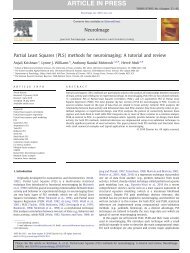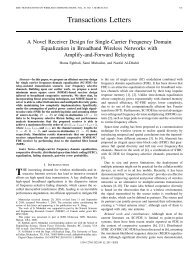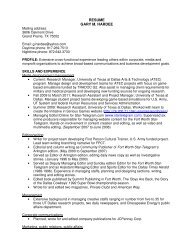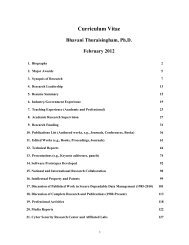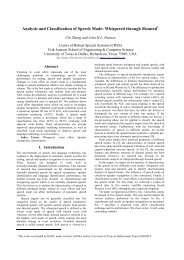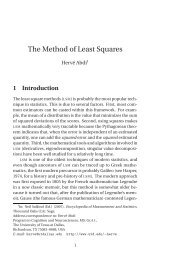what determines the scope of the firm over time? - CiteSeerX
what determines the scope of the firm over time? - CiteSeerX
what determines the scope of the firm over time? - CiteSeerX
You also want an ePaper? Increase the reach of your titles
YUMPU automatically turns print PDFs into web optimized ePapers that Google loves.
2005 Peng, Lee, and Wang631and (4) continuous (now). Williamson (2000: 608)argues that new institutionalism is primarilyconcerned with <strong>the</strong> second and third periods. If<strong>the</strong>se two periods (1–100 years) are reasonableproxies <strong>of</strong> <strong>the</strong> short run, <strong>the</strong>y seem to be a window<strong>of</strong> opportunity during which Proposition 5may find some empirical support.Globally, three sets <strong>of</strong> preliminary evidencebroadly support <strong>the</strong> some<strong>what</strong> counterintuitiveProposition 5. First, throughout emerging economies,many conglomerates spearheaded e-commerce ventures and consequently expanded<strong>the</strong>ir <strong>scope</strong> in <strong>the</strong> 1990s. Second, conglomeratesrecently emerged in China and Russia for <strong>the</strong>first <strong>time</strong>, thus pointing to <strong>the</strong> increasing (notdecreasing) importance <strong>of</strong> institutional relatedness,at least in <strong>the</strong> short run (Peng, 2000). Finally,in Chile and India, <strong>the</strong> <strong>scope</strong> <strong>of</strong> conglomeratesactually increased during a period <strong>of</strong>rapid liberalization (Khanna & Palepu, 1999).DISCUSSION AND CONCLUSIONIn this article we have focused on one <strong>of</strong> <strong>the</strong>four most fundamental questions in strategicmanagement. The article contributes to our understanding<strong>of</strong> <strong>the</strong> <strong>scope</strong> <strong>of</strong> <strong>the</strong> <strong>firm</strong> question byhighlighting <strong>the</strong> importance <strong>of</strong> institutional relatednessin an institution-based <strong>the</strong>ory <strong>of</strong> corporatediversification. Earlier, Peng (2003) articulatedhow institutional transitions matter forstrategic choices in general; we have extendedthis work by specifying under <strong>what</strong> specific institutionalconditions a conglomeration strategymay or may not add value. Since “we need <strong>the</strong>frame-breaking experiences that only comefrom examining and comprehending organizationsoperating in o<strong>the</strong>r places and o<strong>the</strong>r <strong>time</strong>s”(Scott, 1995: 151), we have integrated researchnot only from developed economies but als<strong>of</strong>rom emerging economies. Given <strong>the</strong> typicalone-sided emphasis on product relatedness(which, <strong>of</strong> course, is still important) in <strong>the</strong> literature,it seems imperative that much more researchinvestigate <strong>the</strong> important but <strong>of</strong>tenmissed role <strong>of</strong> institutional relatedness in drivingdiversification decisions and outcomes bothacross <strong>time</strong> and around <strong>the</strong> world.The limitations <strong>of</strong> <strong>the</strong> present article suggesta number <strong>of</strong> future directions. Perhaps <strong>the</strong> foremostlimitation is a focus on <strong>the</strong> nature <strong>of</strong> <strong>the</strong><strong>firm</strong>. The <strong>firm</strong> in developed economies has relativelyclear legal boundaries (Williamson,2000). The conglomerate in many emergingeconomies tends to have blurred boundaries(Peng & Heath, 1996). Such a <strong>firm</strong> is some<strong>time</strong>scalled a “business group.” The difficulty inidentifying its boundaries has not only led tonontrivial measurement problems but also toconceptual debates on whe<strong>the</strong>r such an organizationis a “<strong>firm</strong>.” Thus, future work needs totackle this challenging problem.Second, while researchers have experiencedgreat difficulties in measuring product relatedness,measuring institutional relatedness,which is more informal, unique, and invisible, islikely to be much more challenging. For example,in Chile, Khanna and Palepu relied on “miscellaneousknowledgeable observers” (2000: 273)to identify group linkages. In Indonesia, Fisman(2001) used an idiosyncratic “Suharto DependencyIndex” to measure <strong>firm</strong>s’ connectednesswith former president Suharto. These measuresinevitably carry some “noise.” How to empiricallycapture an inherently invisible and sociallycomplex resource such as institutional relatednessremains a significant challenge.Third, for conglomerates in emerging economies,given <strong>the</strong> long-run needs to contract (Propositions1–4) and <strong>the</strong> short-run incentives to expand<strong>the</strong> <strong>scope</strong> (Proposition 5), where <strong>the</strong> point<strong>of</strong> inflection is remains to be clarified (Peng,2003). Fur<strong>the</strong>r, geographical and technological<strong>scope</strong> (Delios & Beamish, 1999; Peng, 2006;Wright et al., 2005), while beyond <strong>the</strong> <strong>scope</strong> <strong>of</strong>this article, warrants fur<strong>the</strong>r investigation.Overall, <strong>the</strong> question “What <strong>determines</strong> <strong>the</strong><strong>scope</strong> <strong>of</strong> <strong>the</strong> <strong>firm</strong> <strong>over</strong> <strong>time</strong>?” entails complexanswers. We have attempted to capture some <strong>of</strong>this complexity by advancing and leveraging<strong>the</strong> notion <strong>of</strong> institutional relatedness. In conclusion,if this article could contain only one message,we would like it to be a sense <strong>of</strong> <strong>the</strong> staggeringpower <strong>of</strong> institutional frameworks and<strong>the</strong>ir transitions that help determine <strong>the</strong> strategicchoices and performance outcomes for corporatediversification <strong>over</strong> <strong>time</strong>.REFERENCESAdler, P., & Kwon, S. 2002. Social capital: Prospects for a newconcept. Academy <strong>of</strong> Management Review, 27: 17–40.Au, K., Peng, M. W., & Wang, D. 2000. Interlocking directorates,<strong>firm</strong> strategies, and performance in Hong Kong.Asia Pacific Journal <strong>of</strong> Management, 17: 29–47.




